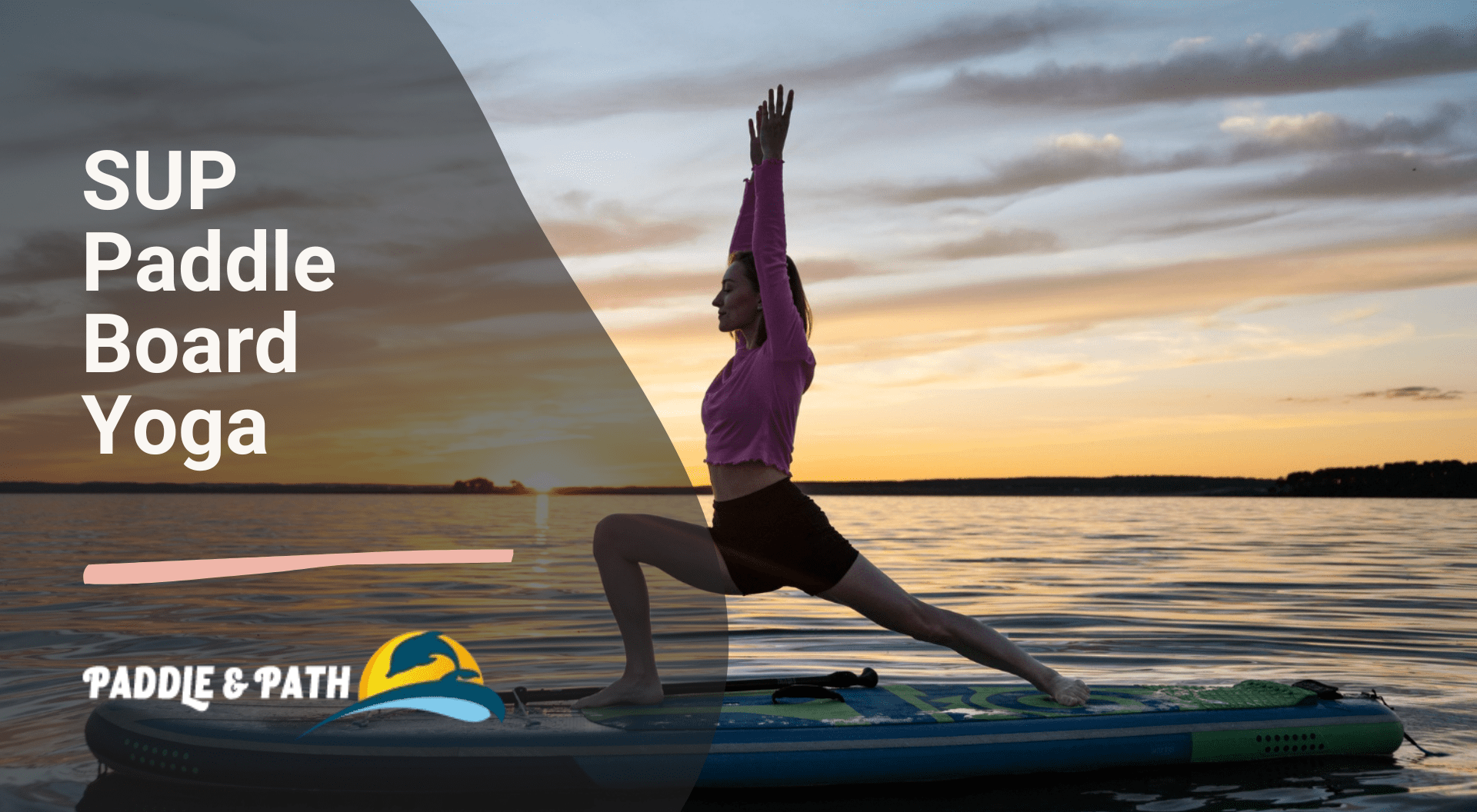Are you looking to take your yoga practice to a whole new level? Look no further than SUP Paddle Board Yoga!
In this comprehensive guide, we will explore everything you need to know about this unique and exciting form of yoga. From its history and origins to the benefits it offers, as well as tips for beginners and advanced variations, we will cover it all.
Get ready to improve your balance, core strength, and mental well-being while enjoying the beauty of nature on your paddle board. Let’s dive in!
Introduction to SUP Paddle Board Yoga
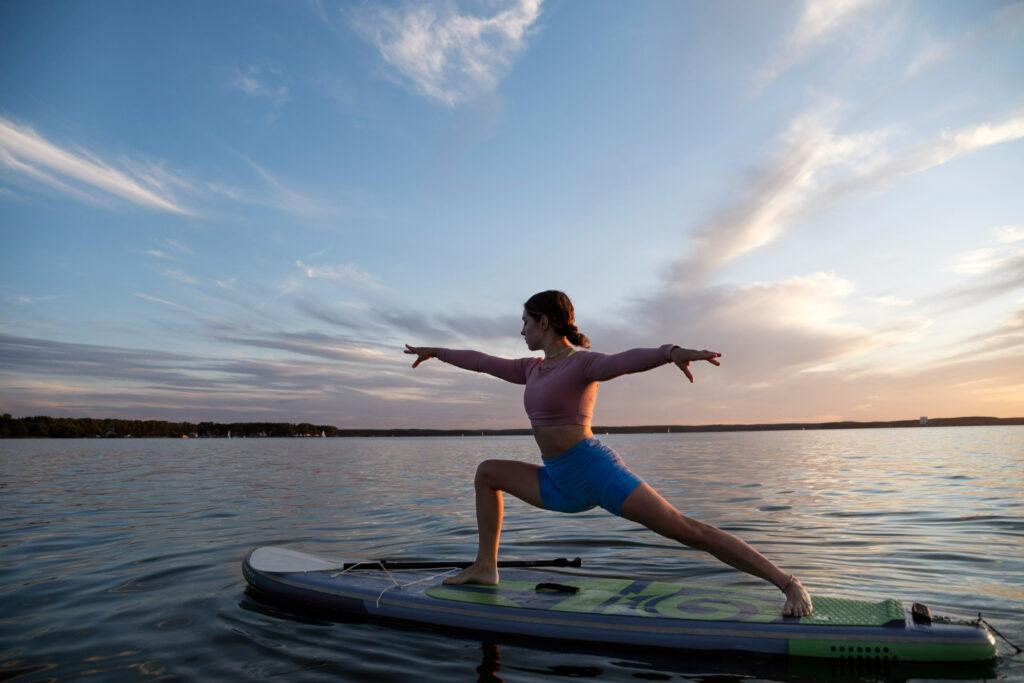
Welcome to the world of SUP Paddle Board Yoga, an invigorating fusion of stand-up paddleboarding and yoga practice atop a paddleboard on serene waters.
This innovative practice not only combines the physical benefits of paddleboarding with the mindfulness of yoga but also offers a unique opportunity to harmonize mind, body, and nature in a serene and picturesque setting. Balancing on the paddleboard intensifies the engagement of core muscles, enhancing stability and strength while performing yoga poses, making it a full-body workout that challenges both physical and mental endurance.
The gentle movement of the water beneath the board adds an additional element of challenge, requiring practitioners to focus on stability and concentration.
This heightened focus on breath control and mindfulness can deepen the yoga practice, helping participants develop a stronger mind-body connection amidst the tranquil surroundings.
What is Stand Up Paddle Board Yoga?
Stand up paddle board yoga is a harmonious blend of traditional yoga poses and techniques performed on a paddleboard floating on water, enhancing balance and core strength.
By practicing SUP Paddle Board Yoga, individuals not only engage in the physical aspects of yoga but also benefit from the meditative and mindfulness elements, heightened by the serene outdoor surroundings and the gentle movement of the water.
Balance is key in this practice, as the unstable surface challenges the practitioner to focus, strengthen muscles, and improve stability. The incorporation of yoga postures and principles into paddleboarding requires a heightened awareness of body alignment and breath control, fostering a deeper mind-body connection.
This unique fusion of disciplines not only provides a full-body workout but also promotes mental clarity, relaxation, and a sense of calm.
Benefits of Yoga on Paddle Boards
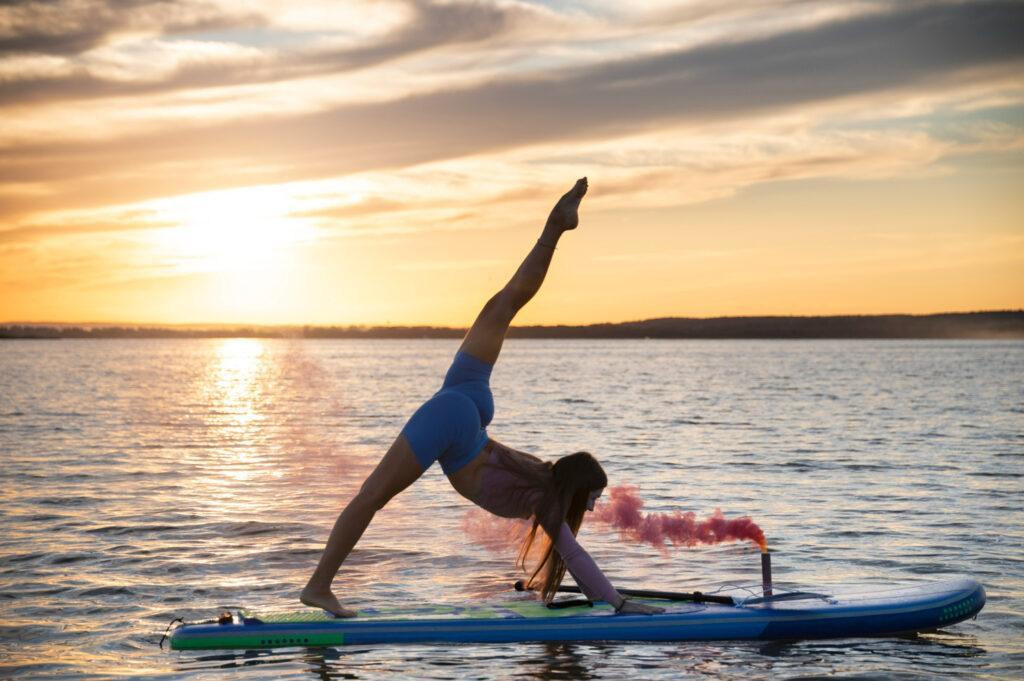
Engaging in yoga on paddle boards offers a myriad of benefits, such as improved balance, strengthened core muscles, enhanced focus, and a deep connection with nature.
On a physical level, the practice of SUP paddle board yoga combines the benefits of traditional yoga with the challenges of balancing on a paddleboard, resulting in stronger muscles, improved posture, and increased flexibility.
Mentally, the serene environment of practicing yoga on the water helps calm the mind, reduce stress, and enhance concentration. The rhythmic sound of water creates a soothing backdrop for meditation and mindfulness.
Emotionally, the sense of freedom and liberation experienced while flowing through poses on an open body of water can promote a deeper connection with oneself and the surrounding environment, fostering a greater sense of peace and well-being.
History and Origins of Paddle Yoga
The history of paddle yoga traces back to the fusion of paddleboarding and yoga disciplines, with roots in ancient yoga traditions and modern water sports culture.
While traditional yoga practices focus on land-based postures and breathing techniques, paddle yoga adds an element of challenge by integrating balance and stability on the water. This innovative practice requires practitioners to adapt to the dynamic nature of the water, enhancing core strength and mindfulness.
The origins of paddle yoga can be linked to the coastal regions where individuals sought harmony with nature through both yoga and water activities.
Equipment Needed for SUP Paddleboard Yoga
Essential equipment for sup paddleboard yoga includes a stable paddleboard, a suitable paddle, comfortable yoga attire, a personal flotation device (PFD) for safety that you can have close by, and optional accessories for enhanced practice.
When embarking on your SUP paddleboard yoga adventure, it’s pivotal to prioritize safety by donning a high-quality personal flotation device (PFD), which can be a literal lifesaver in case of emergencies. Ensure your paddleboard is not only stable but also the right size and shape for your skill level to prevent tipping over during poses.
Choosing the correct paddle is another crucial aspect; a lightweight yet durable paddle with the right length can enhance your performance and reduce strain on your arms.
Comfort is key in every yoga practice, so opt for flexible and moisture-wicking yoga attire that allows you to move freely and comfortably on the water. Investing in optional accessories like a non-slip yoga mat or waterproof phone case can further elevate your paddleboarding experience.
The Connection Between Yoga and Stand-Up Paddle Boarding
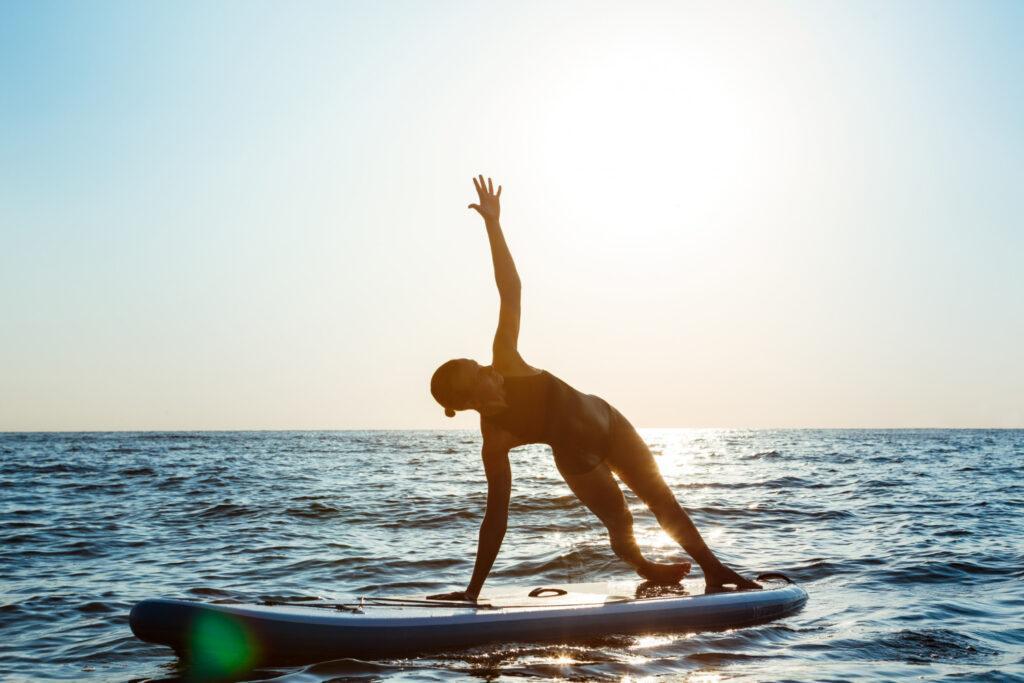
The connection between yoga and stand-up paddle boarding lies in the shared focus on balance, mindfulness, body awareness, and the integration of breath with movement, fostering a harmonious mind-body connection.
Practicing yoga prior to paddleboarding can significantly improve core strength, stability, and flexibility, crucial elements for maintaining balance on a paddleboard. The breathing techniques learned in yoga can also be applied during paddleboarding to enhance focus and reduce stress levels.
The mental clarity and mindfulness cultivated in yoga practice can help paddlers stay calm and centered on the water, especially in challenging conditions.
The Importance of Proper Technique and Safety in SUP Paddle Board Yoga
Adhering to proper technique and safety protocols is paramount in SUP paddle board yoga to prevent injuries, enhance performance, and ensure an enjoyable and secure experience on the water.
Mastering the correct techniques in sup paddle board yoga not only helps in preventing injuries but also plays a crucial role in developing your skills to progress in this invigorating practice.
With the guidance of experienced instructors, you can refine your balance, strength, and focus, elevating your yoga practice to new heights on the gentle currents beneath your board.
Investing time and effort in learning the fundamentals of sup paddle board yoga can lead to a deeper connection with nature, improved physical fitness, and a sense of tranquility as you flow through your poses in harmony with the water.
Tips for Beginners in Standup Paddle Board Yoga
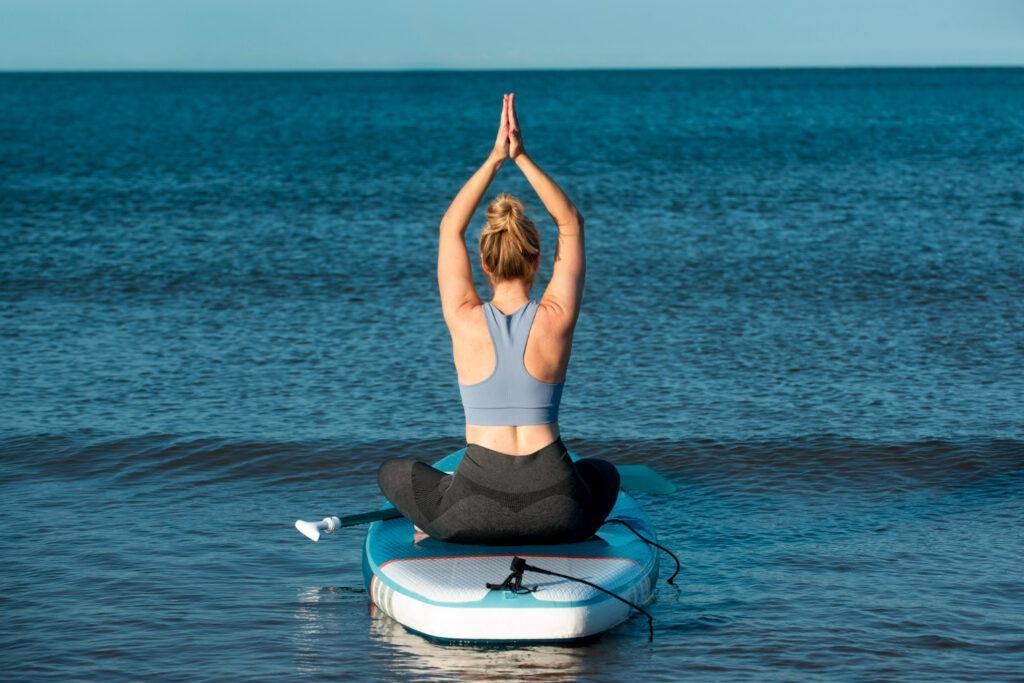
For novices embarking on their standup paddle board yoga journey, essential tips include starting in calm waters, practicing basic poses, maintaining focus on balance, and being open to the experience of falling into the water.
As you progress in your practice, honing your balance becomes paramount; core strength, alignment, and focus are key components in achieving stability on the board. Consistent practice and patience are vital as you build your skills and confidence over time. Remember, setbacks are a natural part of the learning process – embracing these challenges with a positive mindset will help you grow and improve.
Stay open to learning from every experience, whether it’s a wobble or a successful pose, and celebrate your progress along the way.
Popular Poses and Movements in Paddle Board Yoga
Popular poses and movements in Paddle Board Yoga include Downward-Facing Dog, Child’s Pose, Warrior I and II, Tree Pose, Boat Pose, Bridge Pose, Pigeon Pose, Crescent Lunge, and Cobra Pose.
Downward-Facing Dog, known as Adho Mukha Svanasana, helps in stretching the entire body while building arm and shoulder strength.
Child’s Pose or Balasana promotes relaxation, grounding, and release of tension in the back.
Warrior I and II, also called Virabhadrasana I and II, improve balance, strength, and focus.
Tree Pose, or Vrksasana, enhances concentration and stability on the water.
Boat Pose, Navasana, strengthens the core and challenges stability on the paddleboard surface.
Advanced Variations and Challenges in SUP Paddle Board Yoga
Advanced variations and challenges in SUP paddle board yoga push practitioners to elevate their practice with intricate balancing poses, dynamic transitions, sequences, and mindful flow movements on the water.
Transitioning from foundational postures to more complex sequences requires a deep understanding of body alignment and control. As practitioners delve further into SUP paddle board yoga, they may explore advanced techniques such as arm balances, inversions, and deep backbends on the unstable surface of the paddleboard.
The mental fortitude needed to maintain focus and stability while executing demanding postures is a fundamental aspect of mastering these challenging movements.
Practitioners must cultivate a strong sense of mindfulness and presence to conquer the physical and mental obstacles that arise during their practice on the water.
How Yoga on Paddleboards Can Improve Balance and Core Strength
Engaging in yoga on paddleboards is a transformative practice that enhances balance by requiring stability on an unstable surface and strengthens core muscles through the integration of yoga postures that engage the core.
When practicing yoga on a paddleboard, the body constantly adjusts to the movement of the water, which activates smaller stabilizing muscles throughout the body, improving overall balance and proprioception.
The unstable surface of the paddleboard forces the core muscles to engage more deeply in order to maintain stability, leading to greater core strength development over time.
The Mental Benefits of Practicing Stand up Paddle Board Yoga
The mental benefits of stand up paddle board yoga encompass stress relief, enhanced focus, mindfulness, increased body awareness, and a profound sense of tranquility and connection with nature.
Engaging in stand up paddle board yoga offers a unique opportunity to escape the hustle and bustle of everyday life, allowing individuals to immerse themselves in the calming embrace of the outdoor environment. The gentle lapping of water beneath the board and the fresh air caressing the skin create a serene backdrop for practicing yoga postures, fostering a deeply harmonious mind-body connection.
Through the union of breathwork, movement, and natural surroundings, practitioners can cultivate a state of deep inner peace that extends beyond the physical practice.
Combining Paddle Yoga with Meditation and Mindfulness
Integrating paddle yoga with meditation and mindfulness practices amplifies the mind-body benefits, fostering a deeper connection with the surroundings, inner self-awareness, and a harmonious state of presence.
By combining the physical challenges of paddleboarding with the mental clarity gained through meditation, individuals can experience a profound sense of balance and tranquility. Immersion in nature’s serene beauty while practicing yoga on a paddleboard creates a unique sensory experience that heightens mindfulness and encourages a profound sense of oneness with the water.
Through deliberate breathing techniques and focus on the present moment, individuals can quiet the mind, release stress, and enhance their overall well-being both physically and mentally.
The gentle movements of yoga poses performed on a paddleboard challenge balance, core strength, and flexibility, further enhancing the mind-body connection.
Best Locations for SUP Board Yoga Practice
Choosing the best locations for paddle board involves serene lakes, calm rivers, sheltered bays, coastal waters, and picturesque settings that offer tranquility, safety, and natural beauty for a rejuvenating practice.
When seeking an ideal spot for practicing SUP board yoga, one should look for locations that provide a sense of harmony with nature, allowing for a deeper connection with the surroundings.
Imagine gliding through the tranquil waters, with gentle breezes and the sound of nature as your backdrop, enhancing the meditative aspect of your yoga practice.
How to Dress and Prepare for a SUP Yoga Session
Preparing for a SUP yoga session involves wearing comfortable, moisture-wicking attire, applying sunscreen, bringing water for hydration, and considering factors like weather conditions and water temperature for a safe and enjoyable experience.
Choosing the right attire is crucial to ensure you can move freely and comfortably during your session. Opt for breathable fabrics that dry quickly to prevent chafing and discomfort. A rash guard or long-sleeved shirt can provide added protection from the sun’s rays. Remember to apply a waterproof sunscreen to shield your skin from harmful UV exposure.
Hydration is key, so pack a water bottle to keep yourself refreshed throughout your practice. Check the weather forecast before heading out and dress accordingly for the conditions. It’s also wise to consider the water temperature and dress in layers if needed to stay warm during your session.
Different Types of Classes and Instructors for SUP Yoga
Exploring different types of classes and instructors for SUP Yoga reveals a spectrum of offerings, from beginner-friendly sessions to advanced workshops, led by certified yoga teachers and experienced paddleboarding guides.
What distinguishes SUP yoga classes is the wide range of instructors available, each bringing their unique teaching styles and expertise to the tranquil waters. From gentle flows suitable for novices looking to find balance to challenging sequences tailored for seasoned practitioners craving a more intense workout, there is a class for everyone.
These sessions can vary in their focus, be it improving balance, building strength or achieving mindfulness.
The Growing Interest in Stand Up Paddle Yoga and its Community
The escalating enthusiasm for stand up paddle yoga is evident through the burgeoning community of practitioners, instructors, events, retreats, and online resources dedicated to fostering a supportive and vibrant paddleboard yoga community.
Across the globe, individuals are coming together to not just practice yoga on paddleboards but to create bonds, share knowledge, and immerse themselves in nature’s tranquility. The community aspect of stand up paddle yoga goes beyond the physical practice; it fosters friendships, builds a sense of belonging, and encourages a spirit of collaboration.
Group activities like paddleboard yoga classes and workshops provide a platform for participants to connect, learn from each other, and celebrate their achievements collectively.
These shared experiences create a unique camaraderie among paddlers, strengthening the sense of community and mutual support within the paddleboard yoga world.
How Stand Up Paddle Yoga Can Benefit Athletes and Fitness Enthusiasts
For athletes and fitness enthusiasts, stand up paddle yoga offers a dynamic cross-training opportunity that enhances balance, agility, core strength, flexibility, and mental focus, providing a holistic fitness regimen on the water.
One of the standout advantages of incorporating yoga on stand up paddle boards into your routine is the unique blend of physical and mental benefits it delivers.
This practice not only challenges your body through various yoga poses on an unsteady surface but also sharpens your mental resilience as you adapt to the changing elements of the water environment.
Incorporating Yoga on SUPs into a Well-Rounded Fitness Routine
Integrating yoga on sups into a comprehensive fitness routine introduces a dynamic dimension that promotes total-body conditioning, mental wellness, improved flexibility, and a refreshing outdoor workout experience on the water.
Adding yoga on SUPs can complement traditional gym workouts by engaging stabilizing muscles and core strength through the balancing nature of yoga poses on the unstable water surface. This form of yoga emphasizes mindfulness and connection with nature, enhancing the mental benefits of exercise.
The fluid movements required on the paddleboard can improve proprioception and coordination, translating to increased performance in other sports and activities.
Conclusion: Embracing the Challenge and Joy of SUP Paddle Board Yoga.
SUP paddle board yoga offers a transformative journey of self-discovery, physical give the power toment, mental rejuvenation, and a deep connection with the elements, inviting practitioners to embrace the challenges and joys of this unique water-based yoga practice.
Practicing yoga on a paddleboard not only enhances your physical strength and balance but also fosters a sense of mindfulness and focus as you navigate through each pose surrounded by the soothing sounds of water.
The experience of finding your center while floating on gentle waves can be truly liberating, promoting a harmonious blend of nature, body, and mind.
The combination of breathing techniques and challenging postures on a paddleboard demands a heightened level of concentration and inner stability, elevating your yoga practice to new heights of mindfulness and presence.

